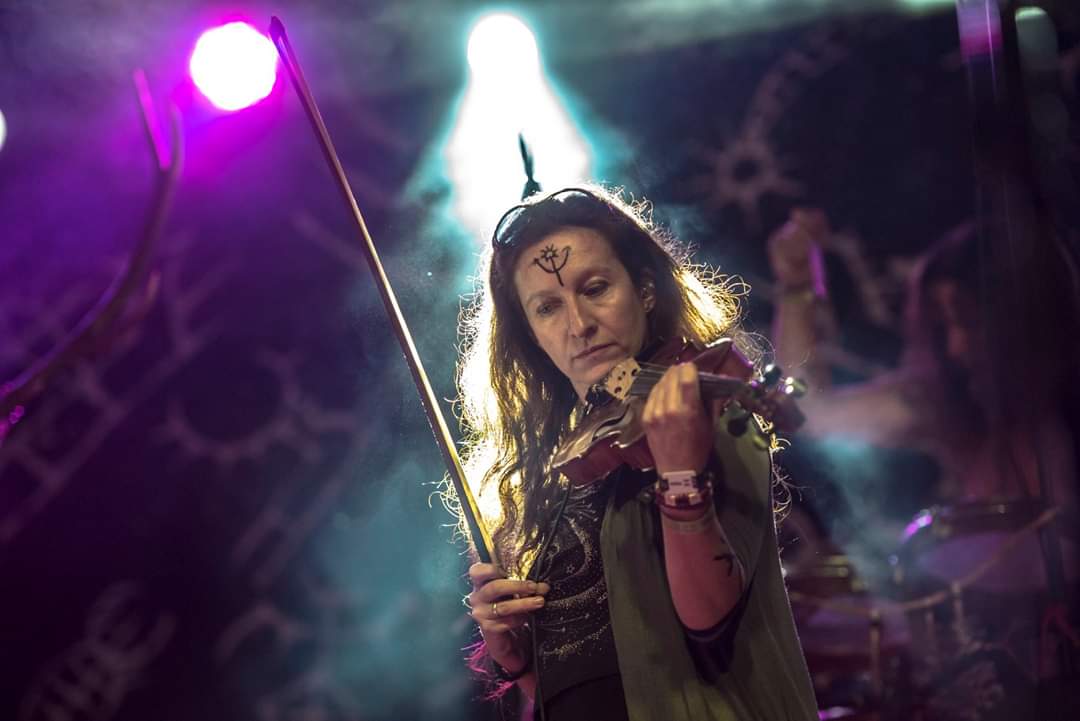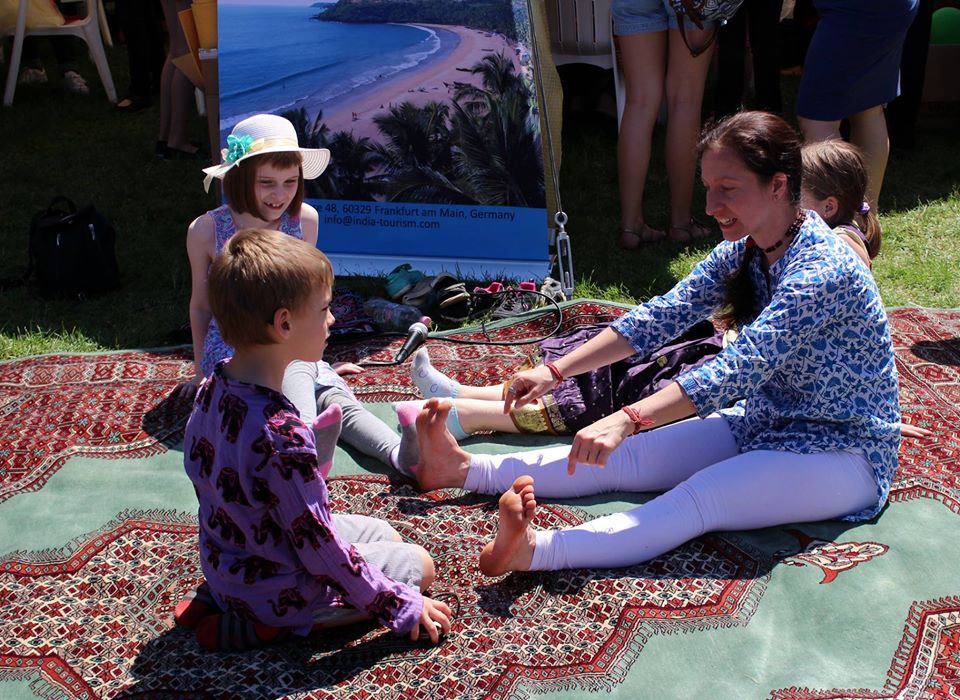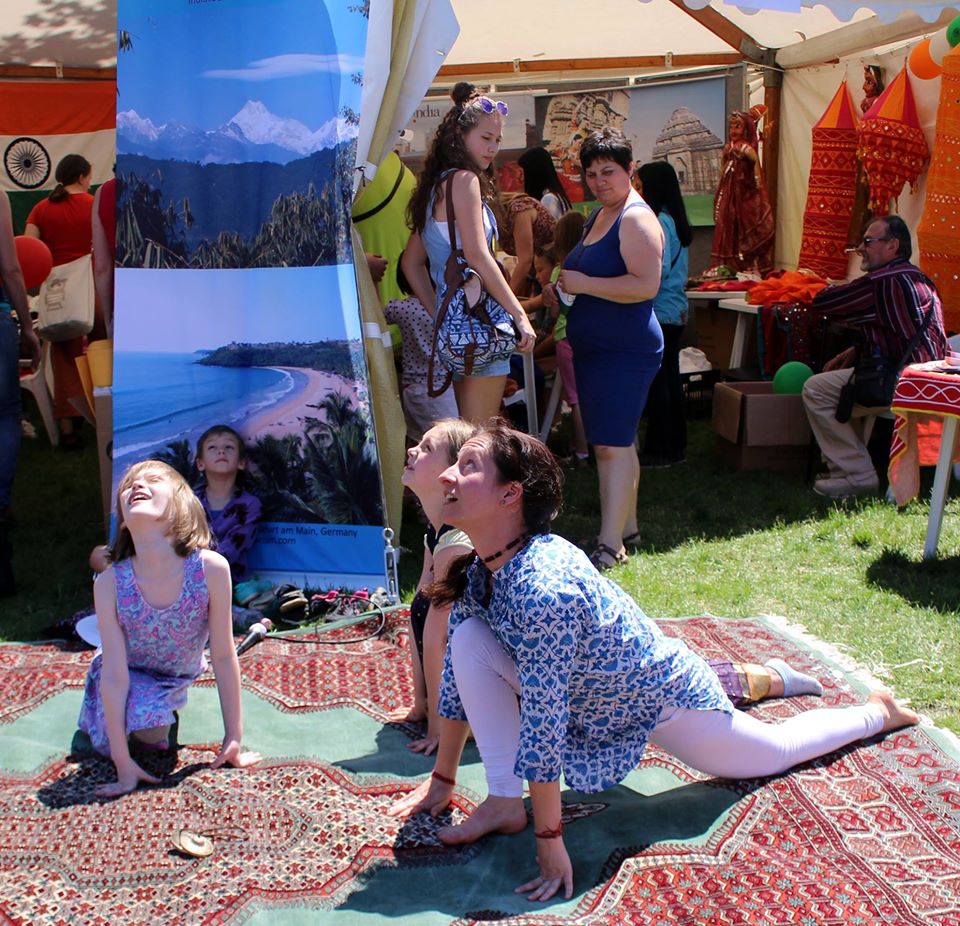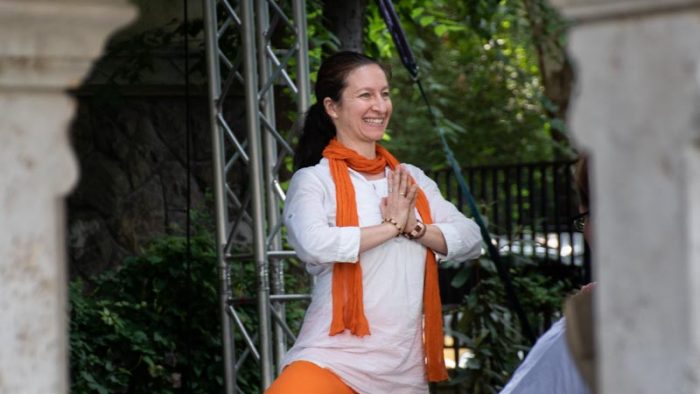Melinda Földiné Irtl is interested in the philosophy and practical applications of Buddhism and Yoga. She has trained as a Buddhist Dharma teacher (TKBF University, Hungary, Budapest) and holds a Masters degree in Yogic Sciences by SVYASA (India, Bangalore). A mother of two small children, she has put to use her certification in Birthlight Yoga for Pregnancy and other methods of Yoga for young mothers.
In this interview she talks about the process of learning and practicing Yoga. She will be speaking at Indica Yoga's session 'Satipatthana Meditation as an Opportunity for Santosha' on July 18th at 11.30 am. Register at: https://indicacademy.zoom.us/webinar/register/WN_muchZRGZQPSUSz2tV0dh8Q
You have studied Yoga in a university environment. How do you compare it to learning from a guru?
Let me start from a little bit of historical and philosophical points. It is all relative and subjective what we think about formal, academical studies related to Yoga or Buddhism. It is true that there are many Western Universities and Colleges dealing with eastern philosophy as theoretical subjects but not all of them.
The open dialogue between East and West brought the interest to develop a kind of bridge between the modern and traditional approaches of the last few decades. I got the blessing to join such institutions both in the field of Yoga and Buddhism and I am thankful indeed for these opportunities. Feeding our intellect with merely philosophy during academic studies could be "useless", if there is no practical value behind. It is likely to be a kind of ego nourishment only, if we are not able to get connected to others throughout our insight (gained by the formal studies) and we cannot make use of it for the welfare of the society. On the other hand blind faith is also an extremity so it is a must to have a so-called scientific, objective attitude to raise our questions about what we are and what we are doing! Both the Yogic and Buddhist traditions encourage us to develop an objective and clear mind by constant practice to be able to gain real understanding.
In fact I got connected informally to the subject and practice of Yoga along with the scientific way of seeing the body, the breath and the mind around 1987 when I was only 9 years old. Therefore some other question will appear: What does Guru mean? Does it only apply to enlightened ones or can it apply to an ordinary man or woman who guides us, gives "initiation" to us into a subject matter and brings light into our life?
Anyhow my formal studies had started in Dharma Gate Buddhist College in 1998 and then I went to India and joined S-VYASA University in Bangalore. Both institutes are good examples of how tradition and formal education could cope well with each other. From the very first moment I got an opportunity to study with bhikkhus, lamas, rinpoches from different Buddhist traditions and I also met with Yoga Gurus from India such as Swami Paramhans Mahswerananda, B.K.S. Iyengar, Swami Veda Bharati, Swami Niranjanananda Saraswati, Acharya Ramachandra G. Bhatt, Dr H.R. Nagendra and many others.
Notwithstanding the fact we have many opportunities to have good teachers who can guide us even in universities, I think I should emphasise that only an ashram or monastic environment gives more confidence and support to go deeper into the subject as it provides direct facility for 24 hours of practice. Meanwhile living in a metropolis, being an active member of the consumer society, running a business, maintaining a family life etc. while we are trying to devote ourselves to spiritual studies (including saadhana) is definitely not so easy.
As a scholar of Buddhism have you compared Indian Yogic practices from say Tibetan Yoga and Tantra practices? What are the main similarities?
Let me skip the deep aspects of this question as many points should be clarified before someone says anything about it. Obviously, so many common methods exist in both traditions, however their names, aims, the way to integrate these practices into someone's personal sadhana could be entirely different.
There are new and novel findings in history, archaeology, linguistics etc. about their common roots, connections, scriptural references, so I am not eligible at this very moment to say anything without having the latest sources about this scientific findings. If we would like to have a simple answer about the main similarities: Indian and Tibetan Yoga and Tantra give us specific tools and techniques on how to understand and become one with our true nature. All the practices deal with/purify/use/educate all the three aspects i.e. the physical, energetic (praanic) and mental (mind). The process of transformation could be different but all techniques and paths could act as supportive elements to reach or realize the state of liberation (moksha, nirvana etc).
Indian universities of the past were the fountainheads of Yoga including Nalanda University. What can we learn from Indian and Buddhist approaches to Yoga in the modern context?
Nalanda and other great monastic universities in India played a great role in that classical darshanas including Samkhya and Yoga or Buddhist philosophy could widely spread. These subjects were taught by great masters. I assume that all of these subjects were very much in tune with the fundamental orientation of the Vedic point of view about what is the real goal of studies. This is nothing new but the knowledge that Vedic process of learning (sravana-manana-nididdhyasana) was applied successfully. In some sense there is no change at all to what Yoga and Buddhism offered to mankind in ancient times and in the very present. At the time of Nalanda around 7-800 A.D. it was well accepted that both paths offered practical guidance for life and both aimed for the removal of suffering and realization of the happiness and freedom aspects. Nowadays, many people turn to Yoga first from the physical aspects only. They consider it first as an alternative fitness program or therapy and it takes time to unfold the deeper philosophical and psychological value of this path.
Nothing is wrong with it, as even Patanjali mentioned that vyadhi is one of the nava-antaraya (9 impediments), so health is very much needed to have a clear and stable mind. The only thing is to be noted in the present era: we might need to practice some more preliminary practices or cleansing techniques as our body and mind is not evidently fit, healthy or capable to grasp the teachings. Our daily life routines, eating habits have changed a lot and we have slowly started to forget to be connected with nature, with ourselves or better to say with our "true nature". Due to unhealthy foods, chemicals, polluted environment, social media etc. delusion had increased so we might need to put in a little more effort than 2-3000 years ago, but definitely it will work if we are doing it with sincere dedication.

Yoga of the past included worship of the Divine? Now there seems to be a deliberate move away from this. When and why did this happen?
Yes, Yoga was probably a kind of method to worship the Divine (upasana). However I assume that it was only seen to be a kind of worship but not based on dogmas or blind faith. If a Yogi has pure consciousness and realization it means divinity appears all around and within so we are not worshipping "some form of deity" as per our taste but celebrate the ultimate divinity all around and within at the same time.
As people moved away from this deep, direct experience and got lost to sense the state of union (yoga), it started to lose its "sacredness".
When Yoga and Buddhism came to the West a new history had started. Only traditional teachers and lineages were able to pass on the real message. When and why did the "move away" happen? It was probably a result of the long process of secularization, industrialization, individualization, World Wars etc. My simple answer is just matched with a well-known quotation from F. Nietzsche - Thus spoke Zarathustra: "God is Dead" (Gott is Tot). Many people got enough from dogmas and lost their faith, so either they became atheists or they had to start questioning or re-discover their religious faith or start revolutionary movements and it is still going on. Fortunately, this is a perfect time for us to change our perspectives on Yoga and Buddhism due to present challenges i.e. pandemic, political, economic, ecological crisis to discover how to get back to the sources and how to solve these global challenges by gaining direct knowledge on truth and divinity, meanwhile we can develop deep compassion to other beings.
How has Yoga been practised in Budapest?
Yoga is quite popular in Hungary. Since 1989 spiritual oriented activities became free from political pressure and prohibitions so all kinds of eastern practice and philosophy (such as Yoga or Buddhism) started to spread slowly. The "secular", non-traditional forms of "urban Yoga" movement started only approximately two decades ago over here, so it is relatively new compared to the USA (where it has started already with the hippies around the 1950s).
Several traditional yoga lineage present in Budapest and have their own centers, shalas, or ashrams i.e. Swami Satyananda (Bihar School of Yoga), Himalaya Yoga tradition (Swami Rama lineage), Yoga in Daily life (Swami Maheswarananda), B.K.S. Iyengar Association, Kundalini Yoga (S.Kaur Khalsa), Sivananda Tradition (Swami Vishnudevananda), Art of Living (Srí Sri Ravi Shankar), ISCON and many others. Beside there are numerous new methods and schools established by Yoga practitioners and they started to run their own Yoga studios and teacher training programs. By now, we have several hundreds of Yoga studios all over the capital, Budapest as well as in all big cities of Hungary. People have the opportunity to get access easily to any kind of fitness, wellness oriented "yoga exercise" or traditional way of Yogic practice and teachings as per their interest.
In your experience with children what aspects of these Yogic traditions do you share?
Not only as a mother of two children, but as a school teacher and as an assistant professor as well I would answer that: the ethical and moral value of Yamas and Niyamas (or the pancha sila in Buddhism). Secondly, whatever yogic lifestyles suggest and could maintain without force including proper diet, cleansing practises, asana, pranayama, dhyana and all. By the way even to be vegetarian without understanding the ethical aspect behind it would be meaningless for a child so Yamas and Niyamas comes first and most.
You have served in different community services. What motivated you to do that?
Let me give short answer: from the point of my Yoga sadhana it is the four brahma viharas, especially karuná, mudita, from the point of my Buddhist dedication is the awakening of the bodhicitta (compassionate heartful mind)
How does the academic study of ancient traditions combined with the practice create change in an individual?
We can say in modern context it is a base for holistic personal development (within the samsaric existence).


Are there different levels of mastery...for instance in your interaction with Yoga practitioners have you observed stages of advancement?
Surely, it is a visible process about progress. It depends on the interest, dedication, sincerity, attitude and many other factors. My observation during the last 20 years of teaching Yoga and meditation is: at least 2-4 years of continuous practice and pure orientation (abhyasa, vairagya) is needed to someone to start to questioning what Yoga is at all, what is basic requirements to step into a path for liberation and what steps should be taken in our life for the sake of "mental purification" (to eliminate kleshas).
Which is the best book on yoga that you have read which could help practioners?
Not "best" but "must" - To understand the basic principles: Patanjali Yoga Sutras.
For practice, it depends on someone orientation:
Swami Satyananda: Asana, Pranayama, Bandha, Mudra, Kriya
Swami Veda Bharati: Philosophy of Hatha Yoga
B.K.S. Iyengar: Light on Yoga
Ian A. Baker: Tibetan Yoga
Who are your inspirations in the world of Yoga. What inspires you about them?
The list is endless as many Gurus and Masters reveal us the path of Yoga and I appreciate and honour all of them who live accordingly and do what he/she teaches. Their kindness, unconditional love and caring attitude along with simplicity, humbleness, humour and compassionate attitude is my inspiration.





